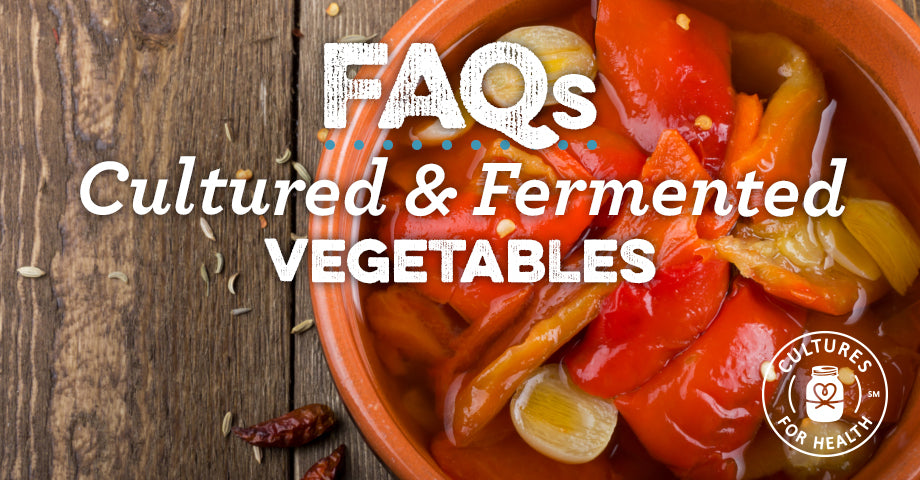
What is Lacto-Fermentation?
Lacto-Fermentation is a method of preserving food that transforms fresh food into favorites such as pickles, chutney, and sauerkraut. Read more in What Is Lacto-fermentation?.
What do I need to get started?
Getting started fermenting vegetables requires very little equipment. Everything needed from the simple to more specialized equipment is described in Fermentation Equipment: Choosing the Right Supplies.
Do I need to wash my vegetables before I start fermenting?
Washing vegetables is a personal choice and is not necessary. Fresh vegetables should have friendly bacteria all over them from the soil. The fermentation process will allow these friendly bacteria to multiply.
What vegetables can be fermented?
Nearly any vegetable can be fermented. Get started with some tried and true cultured vegetable recipes from the Cultures for Health family.
Do I need a vegetable culture or whey to make fermented vegetables?
No. We recommend a salt-only ferment for vegetables. Dried starter cultures may be added in addition to salt, if desired. For more information, see Salt vs. Whey vs. Starter Cultures.
Can I use kombucha or water kefir as a vegetable starter?
Finished, unflavored water kefir or kombucha may be used as a starter culture for fermenting vegetables. Use the same amount as you would whey in any recipe, about ¼ cup per quart of brine.
Can I use the brine from my previous batch to ferment a new batch of vegetables?
The brine from a previous batch of fermented vegetables can be added to a new batch as a starter. Make up the fresh salt brine as directed and add about ¼ cup brine from the previous batch per quart of fresh brine.
What type of salt should I use?
Good quality salt with no additives is the best. There are several good options. Learn about the best options in our article Choosing Salt for Fermentation.
Can I use distilled, alkaline, or mineral water for making brine?
Choosing a good water source is important. Plain water is best. Learn about the best water choices in our article Choosing a Water Source When Making Cultured and Fermented Foods.
How can I keep my vegetables below the brine?
There are a variety of methods for keeping vegetables weighted below the brine. Learn more in our article How to Keep Your Fermenting Vegetables Submerged.
Why do I have to keep my vegetables submerged below the brine?
It is important to keep vegetables in an anaerobic environment during the fermentation period. Reducing oxygen exposure reduces the chance of mold forming.
My recipe calls for oil or cheesecloth on top of the vegetables. Should I use that with my weights?
We do not recommend using oil or cheesecloth with vegetables. Oil can keep out air in a thick layer, but many oils go rancid quickly. Cheesecloth tends to increase the likelihood of mold.
Do I have to use a lid with an airlock?
A lid with an airlock is not necessary for fermenting vegetables. As long as vegetables are kept below the brine, they will turn out well. Some people choose to use a jar or crock with an airlock or water seal. These products, while not required, give great results and discourage mold, which can occur otherwise.
At what temperature should I ferment vegetables?
Vegetables can be cultured at a wider range of temperatures than some other ferments. Please see A Basic Formula for Fermenting Vegetables for more details.
How long will it take for my vegetables to ferment?
Vegetable fermentation can be as short as several days or as long as several weeks. Learn how to tell when your fermented vegetables are ready for cold storage.
How long will my fermented vegetables last in cold storage?
The length of time the fermented vegetables will last depends on several factors including the age of the veggies, type of veggies and what was used for fermentation (salt only, whey, veggie starter, etc.) and storage temperature. Storage time is usually from a few weeks to a few months, but the general rule is to never consume anything that smells or tastes unpleasant.
Will freezing my finished vegetable cultures harm them?
Cultured vegetables can be stored in the freezer. They may soften upon thawing, but will still be full of flavor and beneficial bacteria.
Will cooking damage the cultures?
Heating cultured foods to cooking temperatures will damage the cultures. However, preserving vegetables through lacto-fermentation at the peak of freshness allows cooks to use higher quality of vegetables year round.













